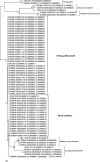Debaryomyces hansenii (Candida famata), a rare human fungal pathogen often misidentified as Pichia guilliermondii (Candida guilliermondii)
- PMID: 18701668
- PMCID: PMC2566122
- DOI: 10.1128/JCM.01451-08
Debaryomyces hansenii (Candida famata), a rare human fungal pathogen often misidentified as Pichia guilliermondii (Candida guilliermondii)
Abstract
Debaryomyces hansenii is a hemiascomycetous yeast commonly found in natural substrates and in various types of cheese. Pichia guilliermondii is widely distributed in nature and is a common constituent of the normal human microflora. Both species have been described in human infections but are extremely difficult to differentiate phenotypically. Thus, frequent errors in identification occur. The 62 clinical and environmental isolates sent between 2000 and 2007 to the French National Reference Center for Mycoses and Antifungals as D. hansenii or P. guilliermondii were analyzed by using the carbon assimilation pattern, the presence of pseudohyphae, and sequencing of the ITS and D1/D2 regions of the rRNA gene. The objective of this study was to assess using nucleotide sequences whether phenotypic identification was accurate and whether phenotypic characteristics could be used to differentiate the two species when sequencing was not available. We found that 58% of the isolates were misidentified and belong to seven different species: P. guilliermondii, P. caribbica, P. jadinii, D. hansenii, Candida palmioleophila, C. haemulonii type II, and Clavispora lusitaniae. In conclusion, D. hansenii may not be as common a human pathogen as previously thought. Sequencing of either ITS or D1/D2 regions is a good tool for differentiating the species more frequently confused with D. hansenii, keeping in mind that reliable databases should be used.
Figures

References
-
- Bai, F. Y. 1996. Separation of Candida fermentati comb. nov. from Candida guilliermondii by DNA base composition and electrophoretic karyotyping. Syst. Appl. Microbiol. 19178-181.
-
- Bai, F. Y., H. Y. Liang, and J. H. Jia. 2000. Taxonomic relationships among the taxa in the Candida guilliermondii complex, as revealed by comparative electrophoretic karyotyping. Int. J. Syst. Evol. Microbiol. 50(Pt. 1)417-422. - PubMed
-
- Barnett, J. A., R. W. Payne, and D. Yarrow. 2000. Yeasts: characteristics and identification, 3rd ed. Cambridge, University Press, Cambridge.
-
- Carrega, G., G. Riccio, L. Santoriello, M. Pasqualini, and R. Pellicci. 1997. Candida famata fungemia in a surgical patient successfully treated with fluconazole. Eur. J. Clin. Microbiol. Infect. Dis. 16698-699. - PubMed
-
- Casal, M., and M. J. Linares. 1981. The comparison of six media for chlamydospore production by Candida albicans. Mycopathologia 76125-128. - PubMed
Publication types
MeSH terms
Substances
Associated data
- Actions
- Actions
- Actions
- Actions
- Actions
- Actions
- Actions
- Actions
- Actions
- Actions
- Actions
- Actions
- Actions
- Actions
- Actions
- Actions
- Actions
- Actions
- Actions
- Actions
- Actions
- Actions
- Actions
- Actions
- Actions
- Actions
- Actions
- Actions
- Actions
- Actions
- Actions
- Actions
- Actions
- Actions
- Actions
- Actions
- Actions
- Actions
- Actions
- Actions
- Actions
- Actions
- Actions
- Actions
- Actions
- Actions
- Actions
- Actions
- Actions
- Actions
- Actions
- Actions
- Actions
- Actions
- Actions
- Actions
- Actions
- Actions
- Actions
- Actions
- Actions
- Actions
- Actions
- Actions
- Actions
- Actions
- Actions
- Actions
- Actions
- Actions
- Actions
- Actions
- Actions
- Actions
- Actions
- Actions
- Actions
- Actions
- Actions
- Actions
- Actions
- Actions
- Actions
- Actions
- Actions
- Actions
- Actions
- Actions
- Actions
- Actions
- Actions
- Actions
- Actions
- Actions
- Actions
- Actions
- Actions
- Actions
- Actions
- Actions
- Actions
- Actions
- Actions
- Actions
- Actions
- Actions
- Actions
- Actions
- Actions
- Actions
- Actions
- Actions
- Actions
- Actions
- Actions
- Actions
- Actions
- Actions
- Actions
- Actions
- Actions
- Actions
- Actions
- Actions
- Actions
- Actions
- Actions
- Actions
- Actions
- Actions
- Actions
- Actions
- Actions
- Actions
- Actions
- Actions
LinkOut - more resources
Full Text Sources
Other Literature Sources
Molecular Biology Databases

